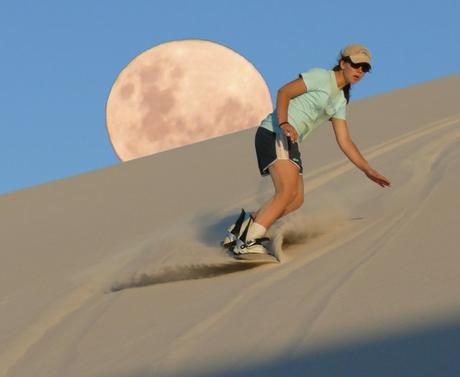When we think of skiing we think of snow, that white powdery stuff that falls from the sky and makes it possible to hurtle down mountains at great speed. Skiing conjures up images of blanket white Alpine villages dotted with gorgeous log cabins and populated by people dressed in heavy winter clothes. Skiing is a winter sport, right? Come summer it’s necessary to pack away the skis and the snowboards and find a different way to appreciate the mountains. Like hiking or high altitude biking.
But what if there was a way to go skiing all year round, in a place where the sun shines the whole day through and the only kind of clothing required is shorts and a t-shirt? Welcome to the wonderful world of desert skiing. Desert skiing — or sand skiing as it’s also known — is an extreme sport that has taken off in desert terrain from Palm Springs, California to Abu Dhabi in the United Arab Emirates.

Like regular skiing, there are two types of desert skiing: cross country and downhill. Similar to its snow-based cousin, desert skiing can be done on a pair of skis or a specially adapted ‘snowboard’. The skills required are much the same as those required by a snow skier: balance, coordination and lots of practice.
Downhill desert skiing takes place on a sand dune or hill — the higher the better. Unlike skiing on a snow slope, where there are usually lifts to get you from A to B, sand skiers have to make their own way to the top.
Cross country desert skiing is a strength and endurance sport that involves skiing over long stretches of sand. Designed to build muscle and increase stamina, it’s a gruelling event that requires a top level of physical fitness.
Equipment
When desert skiing first took off in the 1990s, the equipment was much the same as is used for skiing on snow. Essentially it remains the same: skis and ski poles. The abrasive quality of sand means it’s better to use an old or heavy duty pair of skis to minimise the wear and tear. Sandboards are much more durable than their snow equivalents, and are usually made from formica or laminex. It’s also a good idea to wear a pair of goggles or a visor to avoid getting sand blindness. Desert skiers do not need special clothes — something light will usually do — but it’s a good idea to wear plenty of sun protection and sometimes knee pads in rockier terrain.
Conditions
Just as there are different types of snow, there are different types of sand. Coarse sand is different to fine sand; dry sand is quicker and easier to get across than wet sand. Desert skiers use terms such as fast sand and slow sand. A true desert skiing enthusiast will go to remarkable lengths to find the perfect piece of sand.
Have you ever tried desert skiing or sandboarding?
